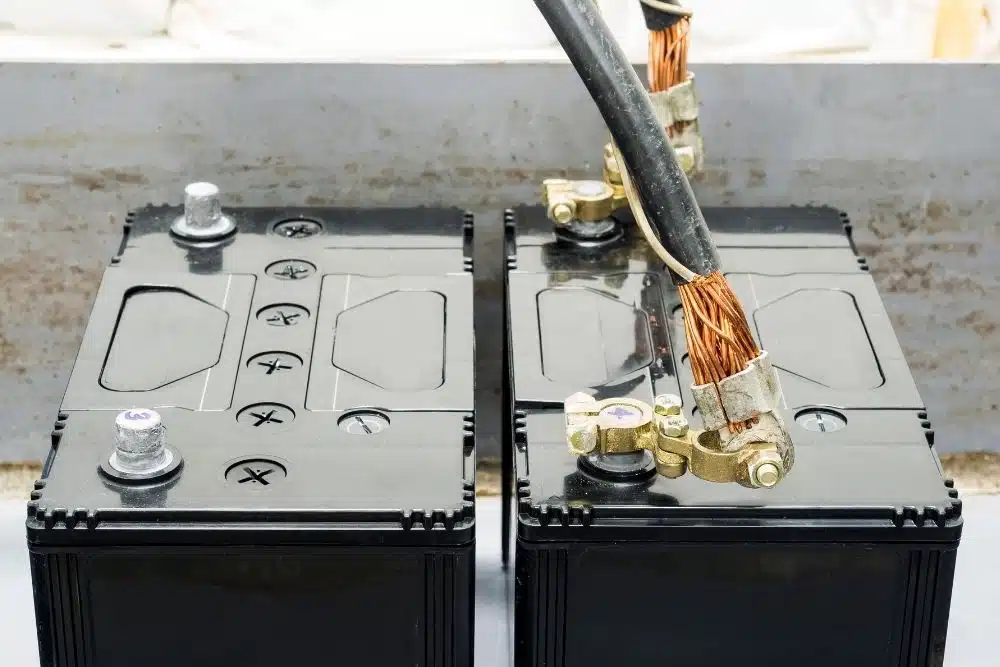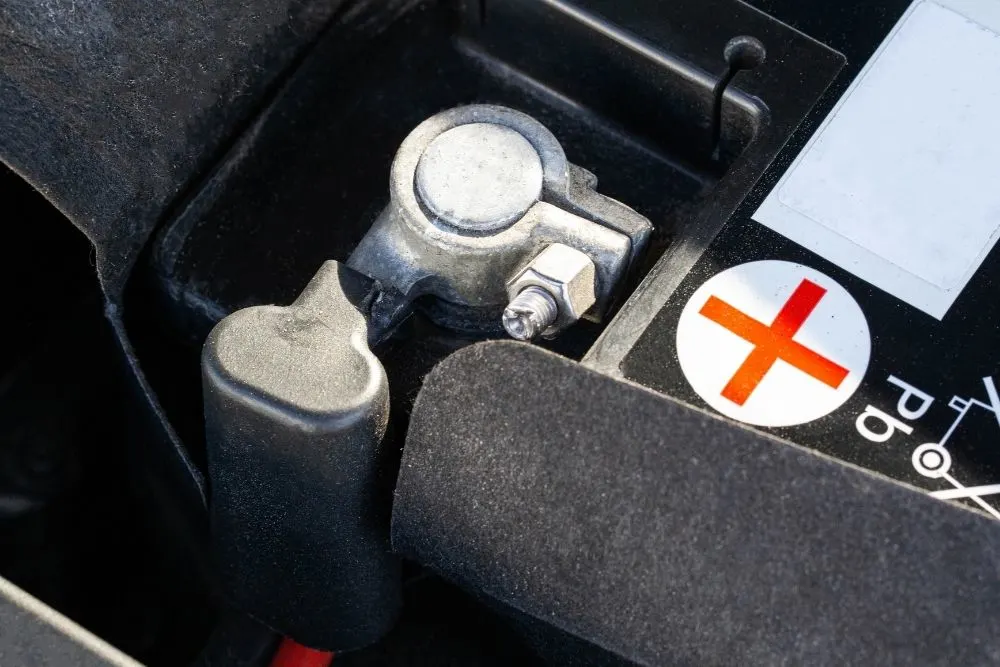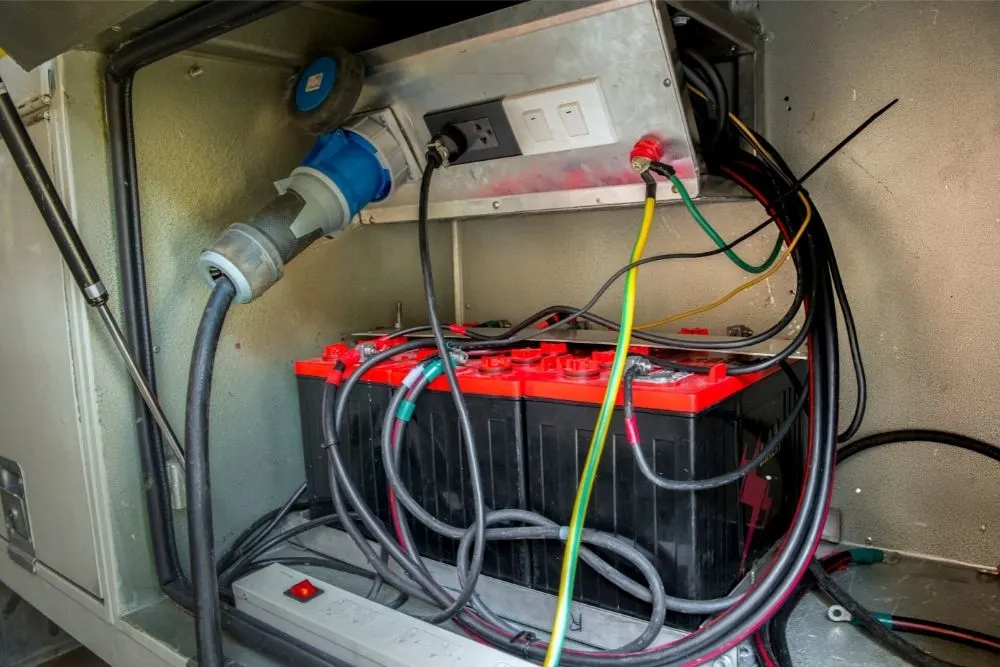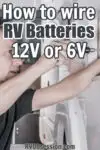A lot of us want to be off-grid when RVing. Away from the crowds (and covid!), out in nature, enjoying the silence, the open spaces and the solitude. But the biggest hurdle for us modern day RVer’s (other than water) is getting enough power. I mean, we have fridges and laptops and water pumps, phones and lights that all need powering.
Having an efficient battery bank that is large enough for your power needs is the first step.
Regardless of what RV battery or batteries you use, it is of course not advised to let them drain completely. For example, lead-acid batteries can become damaged when they’re drained by half, and Lithium-ion batteries can only be drained by 20% before you see damage.

Plus, although you may use a solar panel or generator to charge your RV batteries daily you’re still going to want to have a good amount of power stored up, so you can use as much electricity as you need day and night while avoiding significant damage to your RV batteries.
The easiest solution to this problem is to power your RV with more batteries. But how simple is it to do this?
Below, I’ll take you through the pros and cons of both a 12v battery set-up and a 6v battery set-up, and how you can correctly wire multiple batteries to both.
This post contains affiliate links. Please see our disclosure for more information.
12v Battery Set-Up: Pros And Cons
When not connected to an electrical hook-up, RVs as well as travel trailers, truck campers, vans, and 5th-wheels require 12-volt power to run.
A 12 volt marine deep cycle battery is the most popular type of battery you’ll find in RVs, and these are readily available in stores no matter where you are. When buying from a dealer they will usually install one or two 12v batteries connected in parallel.
12v batteries also tend to cost less than 6v ones, and it’s very easy to connect two 12v batteries together to increase the amp hours.
Amp hours are the unit of measurement that gives you a rough idea of how much storage your RV battery has.
Most RV/Marine deep cycle batteries can store about 35-70 amp hours, but you can also purchase deep cycle RV batteries with significantly more or less amp hour storage.
If you camp without a hook-up on the weekend, or if you’re a full-time RVer who tends to camp with hookups in RV parks or campgrounds, I would suggest a battery set-up with at least 70 amp hours, regardless if it is with one or two 12v RV batteries.
12v Pros
- It only takes one 12v battery to power an RV. But if you have two 12v batteries this comes in handy if one of the batteries fails.
- 12v deep cycle RV batteries are often more budget-friendly.
- You can easily find them in smaller, regular stores.
- Each 12v battery that is connected in parallel increases amp hours. If connected properly, you can add as many 12v batteries as you like.
12v Cons
- The more amp hours a 12v battery can store, the larger it gets. For example, one 200ah 12v AGM deep cycle RV battery can weigh up to 114 lbs.
- Not as durable as a 6v battery, but a high-quality 12v battery (such as AGM, Gel, or Lithium) that isn’t a marine deep cycle battery can be fairly hardy.
- If you have a smaller storage area in your RV for your battery it may not be able to accommodate a larger 12v high amp hour battery.
6v Battery Set-Up: Pros And Cons
You may be wondering why you would want a 6v battery set-up for your RV. After all, RVs run on 12v power, right? Well, there are ways that I will discuss below that you can wire batteries together, and these are series and parallel.
Wiring a 6v battery parallel is the same as wiring 12v RV batteries, as you are making the batteries larger while keeping the voltage the same. However, when wiring in series you are increasing the voltage, but the amp hour capacity remains the same.
Since 12 volts is needed to power an RV, you therefore need at least two 6v batteries to power it. To add more batteries in the future these will also need to be added in pairs. Most RVers have their two 6v batteries wired in series, and a 6v 225ah AGM deep cycle RV battery weighs around 71 lbs.
When two of these batteries are combined, you get a 12v battery that is still 225ah.
This is perhaps simpler to understand when you consider this in watt-hours, and you can calculate the watt-hours of a battery by multiplying the total voltage by the amp hours. For example, one 12v RV battery with 100ah will have 1,200 watt hours, while two 12v RV batteries with 100ah will have 2,400 watt-hours.
Meanwhile, one 6v RV battery with 225ah will have 1,350 watt-hours. You may have noticed that while the amp hours are significantly more on the 6v battery than the 12v battery, the watt-hours will be fairly similar. This is simply because you are multiplying by 6 and not by 12. Therefore, two 6v batteries with 225ah will equal 2,700 watt-hours.
6v Pros
- Often, 6v batteries are more durable than 12v batteries. For example, 12v marine deep cycle batteries that are not actually deep cycle batteries are not great to use in your RV.
- More manageable than larger 12v batteries.
- Don’t take up as much space as 12v batteries.
6v Cons
- If you have two 6v batteries and one of them fails, you will not be able to run your RV.
- Not as easy to find in regular stores than 12v batteries.
- Not as budget-friendly as 12v batteries.
Correctly Wiring Multiple 12 Volt Batteries To An RV

It’s actually not too difficult to wire more than one 12v RV battery to an RV and you typically don’t need to call a professional in. However, there could be a couple of ways in which it can go wrong.
Your aim is to correctly wire the 12v batteries together in parallel, so there is even balance of power between all the batteries. This not only extends the life of your batteries, but helps them to work better.
Firstly, you will need the proper wire to wire the RV batteries together. The recommended sizes are 6-4 AWG copper wire, with 4 AWG being the most effective as it has the least resistance, making the transfer of power from the batteries more efficient.
Of course, every battery set-up will differ depending on the size of the batteries you’re using and the area where they will be stored, but you can’t go wrong with a generous length of red and black 4 AWG copper wire with the correct type of battery terminal connectors.
The Windy Nation 4 AWG Wire Kit is ideal for most deep cycle RV batteries and has enough wire length for average connections. But if you would like to wire together over 4 RV batteries or there will be quite a bit of distance between the batteries connecting, it’s best to buy more to be safe.
To correctly wire your batteries you will also need to have a crimping tool to hand, like this IWISS Cable Lug Crimping Tool. You can attempt the wiring without it, but it will be difficult to get tight or secure connections without it. This could lead to more resistance, and your battery may not work at all.
Parallel wiring: When connecting batteries through the parallel method you combine positive terminals to the positive ones and the negative terminals to the negative ones. This means that you create a larger battery with the same voltage.
However, you can’t combine batteries with different voltages, and I would warn against combining batteries of different sizes and ages, although it is possible to do so through the parallel method. When wiring 12v batteries you need to use the parallel method, as you want the voltage to stay the same.
This is in contrast to 6v batteries where you want to increase the voltage.
The incorrect way to parallel connect 12v batteries: If your load wires that connect the batteries to your RV have been placed on the same battery, then you’ve incorrectly parallel connected the 12v batteries. This puts an uneven amount of pressure on the first battery, and not enough pressure on the last battery in the line.
If you parallel wire your RV batteries this way, the original batteries will drain much faster than the other ones. The load instead needs to be distributed evenly, so the batteries are charging and discharging simultaneously.
The correct way to parallel connect 12v batteries: Each wire running from each battery needs to measure the same length, otherwise more resistance is added to the one battery and this causes the circuit to be unbalanced. However, a flaw in this method is that not everybody will have the space in their RV to add external terminal posts.
If you would like to create a big solar power bank with more than 8 batteries you need to make sure you use the parallel method correctly to keep your batteries in good condition, but for a couple more RV batteries there are other ways you can wire your batteries for more balanced batteries.
Wiring 2 12v batteries to an RV: This is one of the most popular battery set-ups, and what most RV manufacturers and dealers accommodate for. What makes this method correct is that it involves the load wires from the RV being connected to different batteries. This distributes the load evenly and gives you a more balanced circuit.
Wiring 3 12v batteries to an RV: As soon as you start adding over two batteries with this method, the less efficient it becomes. Still, adding another battery shouldn’t make too much of a difference, so you can add a third 12v RV battery the same way as you would add a second.
The load wires should still be placed on the outer batteries, in order for the middle battery to distribute power evenly. The battery in the middle will be releasing fewer amps than the two batteries on the end, but this difference should be minimal.
For three perfectly balanced RV batteries, then you can turn to the parallel method or the cross-diagonal method I’ll be discussing shortly.
Wiring 4 12v batteries to an RV: When adding 4 batteries to your RV, the wiring gets a bit more complicated. You can still chain the terminals together like the methods above, but this makes things more unbalanced. You start by connecting two pairs of batteries with a short wire.
You then connect the two pairs of batteries with a long wire, combing the two groups of batteries. You then connect your load RV power wires to the terminal in the middle with the short and long wire on it, making sure the negative and positive load wires are connected to two separate batteries.
Once everything is wired correctly, the load wires should connect to the batteries in the middle. Every battery should have a long and short wire connected to it that keeps the batteries balanced and the four batteries even. Adding a few different types of connections gives you the optimum balance, more than a standard chain of connections that has load wires on their ends.
However, if 4 batteries placed next to each other won’t fit in your battery storage space, then you can connect them using the cross-diagonal method. In the cross-diagonal method, each battery has a long and short connecting wire that is still perfectly balanced.
Correctly Wiring Multiple 6v Batteries To An RV

If you would like to power your RV with more durable batteries and want batteries with more total amp hours, then 6v batteries might be the right choice for you. As we have already discussed, there are arguments for and against using 6v batteries over 12v batteries, but ultimately what batteries are best for you will depend on personal preference.
Wiring 6v RV batteries is slightly different to wiring 12v batteries. The voltage will need to be increased to 12 volts, as an RV cannot run on just 6 volts. You can increase the voltage by wiring two 6v batteries together in series by connecting a positive and a negative. This increases the voltage while the amperage remains the same.
For example, if you wire two 12v 100ah deep cycle RV batteries together in parallel you still have 12 volts but 200ah. However, if you wire two 200ah 6v batteries together in series you still have 12 volts and the amp hours stay at 200.
Fortunately, you can combine series and parallel wiring with 6v batteries, meaning you can combine 4 or more batteries and keep the voltage at 12 while increasing the amp hours. However, you should never combine different amp hour 6v batteries. You must always use the same size, type, and – if you can – age.
Wiring 2 6v batteries to an RV: Firstly, connect the 6v batteries in series, so you now have a 12v battery. This can be achieved with a small piece of wire such as the 4 AWG copper wire mentioned earlier. You still attach the load wires to different batteries, and you should never have both load wires connected to one 6v battery.
Wiring 4 6v batteries to an RV: If you’ve wired 2 6v batteries in series to make a 12v battery then it’s simple to wire 2 or more 6v batteries together in series or parallel to get more amp hours. You can do this by combining each pair of 6v batteries, and then wire them together in parallel like you would with 2 12v batteries.
However, you should make sure you connect the load (or the RV power) wires to different pairs of 6v batteries. This doesn’t just balance the batteries out, but helps them to last longer too.
Wiring 6 6v batteries to an RV: With 6v batteries you can create large battery banks, but using over 4 6v batteries will be significantly heavy, even for RV use. But if you need a lot of energy for your RV, you can easily wire 6 6v RV batteries together with the same series/parallel method.
The batteries need to be suitably balanced, just like wiring 3 12v batteries together. For more balance you can use the cross-diagonal method to balance them further, but it won’t make too much of a difference.
Frequently Asked Questions
What AWG Of Wire Should I Use To Connect RV Batteries Together?
4 AWG is usually the best for connecting RV batteries together but 6 AWG will also provide good results.
When Multiple Batteries Are Wired Together, Where Is The Battery Charger Connected?
The battery charger always needs to be connected to the same battery terminals that the load wires are connected to. This makes sure the batteries charge evenly, meaning that no battery is overcharged while the other batteries on the same circuit are getting charged appropriately.
Do I Need Two Batteries For mMy RV?
It all depends on the voltage of your batteries. If you are using 6v RV batteries then you will need at least two in order to achieve the 12 volts of power needed to power the RV. If you are using 12v batteries then you only require one, but it is recommended to get either a large 100ah 12v deep cycle RV battery, or two smaller 35-50ah 12v deep cycle RV batteries.
Can I Combine Batteries With Different Amp Hours (ah)?
Again, it all depends on what batteries you have and how you plan on wiring them.
If you are wiring 6v batteries in a series then you shouldn’t mix batteries with different amp hours. However, if you are wiring in parallel like you normally would with 12v batteries, then you can use different size batteries as long as the voltage is the same.
However, I cannot stress enough how important it is not to mix batteries of different ages. Anything with a 6-month age difference you shouldn’t wire together.
Should An RV Always Be Plugged In?
If you would like to leave your RV constantly plugged in all the time, you need to first check to make sure your RV has a smart or 3-stage charger in the converter. Older RV models may just have an older type of trickle charger in the converter that can overcharge your batteries, which can be as damaging as your batteries dying completely.
However, if your RV does have an older charger, you can easily replace it with a different, newer one. If you have a smart or 3-stage charger in your RV then always leaving the batteries plugged in should be safe to do.
However, you should always regularly check on your batteries and monitor their water levels to see if the batteries are flooded with lead-acid.
Is It Better To Wire RV Batteries In Series Or Parallel?
Again, this will all depend on what type of batteries you are using.
12v batteries always need to be wired using the parallel method, so the voltage is the same, but the amperage is increased. However, 6v batteries need to be wired in series and in pairs, so they have the same power as a 12v battery.
When two 6v batteries are wired together in series, you can then wire them to another pair of 6v batteries using the parallel method.
What Is The Difference Between Wiring RV Batteries In Series And Wiring RV Batteries In Parallel?
When batteries are wired in series then the voltage is increased. For example, two 12v batteries that are wired in series will turn into a huge 24v battery, which is a bit excessive for use in an RV. This is why you instead wire them in parallel, so the amp hours are increased rather than the voltage.
Since wiring batteries in series increases the voltage, you can connect two 6v batteries. This creates a 12v battery that is now adequate to power an RV.
Do RV Batteries Wired In Parallel Have A Longer Lifespan?
When wired correctly and with the right balance, 12v batteries that are wired in parallel definitely have a longer lifespan. However, if incorrectly wired, then the battery that is directly connected to the RV may drain and wear out sooner than the other batteries.
Wiring in series can take more of a toll on batteries, but 6v batteries are preferred for their durability, and the difference between 2 6v batteries wired in series compared to two high-quality 12v RV deep cycle batteries wired in parallel is extremely minimal.
Final Thoughts
Your RV uses a lot of power to truly make it a home away from home, and your RV needs to be powered by a battery that can meet its demands.
A 12v battery provides an adequate voltage, while you will need two 6v batteries to properly power your RV. However, even when your RV is powered by a 12v battery, it is recommended to wire multiple batteries to the original, in case your original battery fails.
Luckily, wiring multiple batteries is easy using one of three methods; wiring batteries in parallel, wiring batteries in series, or using the cross-diagonal method.
Whatever method you choose, make sure the batteries you’re using are compatible in age, type, and size, and that they can distribute power evenly.

